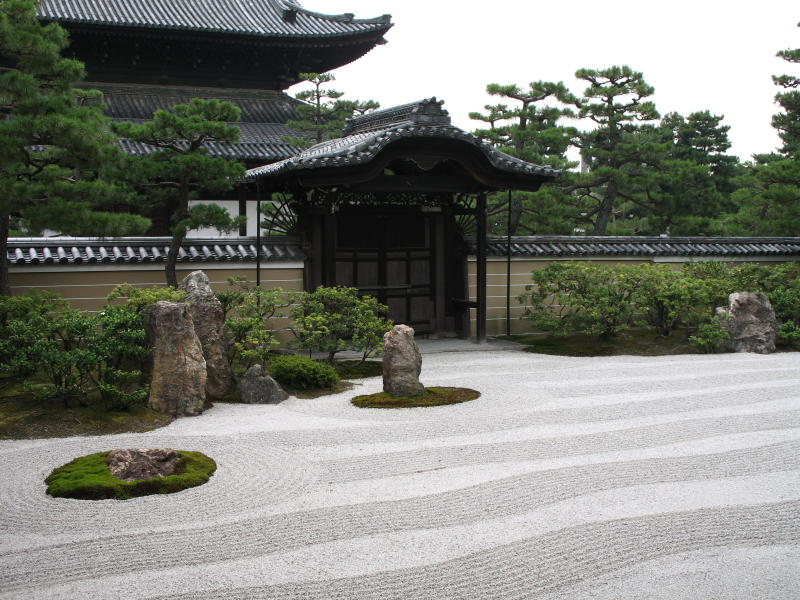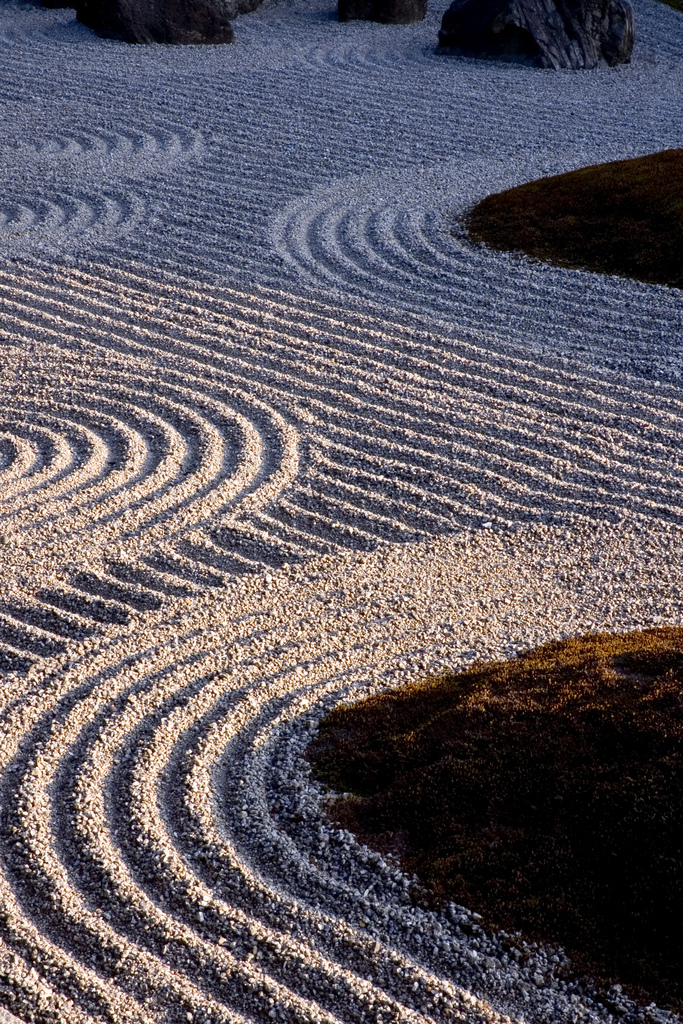
This site is occasionally used as the site for a live classroom. It may also be used as a blogging assignment or for your non-academic edification. If you are not in the Live Classroom, just disregard the classroom instructions.
RYOKIN SAND GARDEN OF KYOTO
We will explore important themes in Japanese Zen Buddhism through images from the arts. 'Zen' is the Japanese word for the Chinese 'Ch'an.' 'Ch'an' is the Chinese word for the Sanskrit, 'Dhyan.' 'Dhyan' is an Indian word which simply means 'meditation.' Buddhism arose in India and migrated to China, then Japan, and to other Asian countries. Many of the greatest Zen artworks and Buddhist temples are in the ancient Japanese city of Kyoto, which is a place of pilgrimage. Basho, the greatest master of Japanese poetry, wrote this Haiku:
Even in Kyoto,
Hearing the kuku's cry,
I long for Kyoto.
Using your imagination, take a slow 'mindfulness walk' around the famous sand garden in the Ryokin temple. Walk through the following pictures, scrolling down and breathing slow, full, but natural breaths. What feelings arise in you? What sensations arise in your body? How does the Zen Buddhist sand garden effect your mind and body?
Stop here and write your end of course Blog.
____________________________________________
Zen Sand Garden In American Culture
Miniature sand gardens are becoming very popular in America (picture #2). You can create a "still life" of rocks and sand on a table, in a meditation space, in your own house. What purpose do you think these miniature gardens serve?
2.

SUMI-E INK PAINTING
Emptiness (Sunya)
Pictures #3 and #4 below show the Enso, the "Empty Circle." Why do you think the empty circle is a major subject of Buddhist art? What qualities do you see or feel in the brush stroke? How is the Enso like the sand garden?
3.

4.

Emptiness In Quantum Physics
In picture #5 below, an atom is depicted. In relative terms, the distance between the nucleus and the electrons is actually much greater than this picture depicts. The atoms that compose our bodies are mostly empty space. Empty space pervades the material world, and every sub-atomic particle is the excitation, or vibration, of an empty vacuum. Here's a statement from Steven Hawking, one of our foremost living physicists: ""In the case of the whole universe, one can show that the negative gravitational energy exactly cancels the positive energy of the matter. So the total energy of the universe is zero." Is the universe of modern quantum physics a giant Enso?
5.
![]()
Plum Blossoms
In the painting below (picture #6) do you perceive any qualities of Buddhist philosophy?
6.

Persimmons
Below is a famous masterpiece of Master Mu Ch'i: Persimmons (#7). What Buddhist qualities are conveyed by this painting? What do these persimmons symbolize? Or are they just persimmons?
7.

Pesimmons when unripe are painfully hard and bitter, but when ripe, lusciously sweet and soft. But is there such a thing as being too ripe? Some have suggested that these persimmons represent Buddhist disciples at various degrees of enlightenment. Is one of them the Master? In what ways does this simple painting express Sunya, the Enso, the Middle Way, the play of emptiness and fullness?
In an online live classroom, a student named Ramona H. said of this painting: "Each creature, imperfect perfection!"
Stop here for a short writing exercise...
_______________________________
Anatta: No-Self
Note the rough spontaneous brush strokes in the landscape below (picture #8). This painting is almost abstract, like a 20th Century 'expressionist' painting, wild and free in style as the stormy scene it depicts. In fact, Zen art influenced modern European painters like Van Gogh and Matisse.
8.

Buddhism de-emphasizes the human ego, teaching Anatta: no-self. This does not mean that humans have no being! It means that we have no separate being. We are inter-connected with all nature. Does the landscape in the painting above suggest any message about the human ego in relation to nature? Look carefully.

Karst mountain formations near Guilin, China. This scene in modern China gives some basis in the natural world for the quality of Buddhist and Taoist landscape art, don't you think?
Thich Nath Hanh: Video Link
Thich Nath Hanh speaks on breathing and mindfulness: the essential Buddhist meditation practice for centering in the miracle of the present moment. Your Discussion Board Forum in Buddhism contains a talk by Thich Naht Hanh, as well as further mindfulness meditation instructions. Click the 'video link' above.
Daibutsu (Giant Buddha)
Below is the Daibutsu of Kyoto (#9), the largest Buddhist statue in the world, 46 meters high, built in the 16th Century.
9.

Sakyamuni, the historical Buddha, is usually shown sitting in this posture: the lotus posture of mindfulness. Eyes gaze inward, closed or half-open. Weight centers at the base of the spine. Body is relaxed but alert. Mind is clear, calm and empty. Breath unites body and mind, and brings us to the present moment. You don't have to be 46 meters high to do this, for you too can be Buddha! Remember, Buddha simply means, awake.
_______________________________________________
From Hakuin's 'SONG OF ZAZEN'
Hakuin was the 17th century founder of the Rinzai school of Zen Buddhism in Japan. He was also a great poet and artist of Sumi-e ink paintings, as in his humorous self portrait below, showing "the sound of one hand clapping."
10.

"All sentient beings are essentially Buddhas.
there are no Buddhas.
bathing in a fresh mountain stream,
cries out in thirst.
just being here.
the unobstructed sky of the heart!
the perfect moonlight of wisdom!



































































































